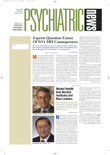Depression is typically thought of as a mental illness that affects an individual. But one family advocate wants it known that depression is really a family illness—one that requires support from parents and siblings. Yet most family members are ill equipped to recognize the signs of depression in a family member and get that person into treatment.
Julie Totten, founder and president of Families for Depression Awareness, was one of those family members. She knew that something was wrong with her brother but wasn’t sure what it was. Even the family doctor did not detect her brother’s illness. He showed many of the physical manifestations of major depression—headaches, stomach upset, and fatigue—but did not discuss his symptoms with anyone. He committed suicide 12 years ago at the age of 26.
“It is really sad what happened to my family,” Totten told Psychiatric News. “We lost my brother when he probably could have been saved.”
Not too long after her brother’s suicide, Totten recognized similar signs of depression in her father. She helped him find psychiatric treatment, and he’s been doing well ever since.
Totten founded Families for Depression Awareness two years ago to give families the education and support they need to recognize the signs and symptoms of depression.
Another mission of the Watertown, Mass.–based organization is to promote sharing and communication among family members who are living with or caring for a family member with depression.
“All too often,” said Totten, “there is so much social stigma around depression that families won’t seek help for a depressed family member, and they won’t talk about the problem among themselves.”
Totten has yet another family-related link to depression—through her mother’s remarriage. After her first marriage ended, her mother married a man named Al Sexton, who had been married to the American poet Anne Sexton.
Anne Sexton is one in a long line of “confessional” poets who expressed their mental anguish through poetry. She began writing in the late 1950s and was later diagnosed with bipolar disorder and alcohol dependence. She took her life in 1974, a year after her divorce from her husband. Sexton’s psychiatrist posthumously released more than 300 audiotapes of his therapy sessions with her to author Diane Wood Middlebrook, who used the content of the tapes to write Anne Sexton: A Biography.
Linda Sexton, who is Sexton’s daughter and Totten’s stepsister, speaks on behalf of Families for Depression Awareness about her own experiences with bipolar disorder and her tumultuous relationship with her mother.
Totten said that certain family members who emerge as caregivers for a depressed relative may develop depression themselves. “Taking care of someone with depression can be a stressful experience. That is why it is important to bring the entire family together to offer one another support,” she said.
Family Profiles Given
In her work as a family advocate, Totten has seen how depression can cause families to become fragmented. With communication, education, and support, however, many families become whole again.
Some of these families are featured on the Families for Depression Awareness Web site under the “Family Profiles” section. One profile describes the hardships facing William Styron, author of Sophie’s Choice, who experienced a severe bout of depression at the age of 60. Styron’s wife, Rose, facilitated the hospital stay that helped him to recover.
Another profile describes the struggles of Bill and Nancy, parents of 12-year-old Ally, whose oppositional behavior began at the age of 9 months. They searched for years before finding a doctor who correctly diagnosed Ally’s bipolar disorder and provided appropriate treatment.
The site also offers people with depression and their families a number of support mechanisms: basic information about the prevalence, diagnosis, and treatment of depression; books on how families can cope with depression; and lists of support groups for people with depression and their families.
The organization has partnered with a number of groups, such as the National Alliance for the Mentally Ill and the Depressive and Bipolar Support Alliance (formerly the National Depressive and Manic-Depressive Association), to educate the public about the effects of depression on families.
Protective Factors Explained
William Beardslee, M.D., physician in chief and chair of psychiatry at Children’s Hospital in Boston and the Gardner Monks professor of child psychiatry at Harvard Medical School, is a member of the Families for Depression Awareness advisory board. He speaks regularly to both health care professionals and families about the organization and its mission.
His latest book, Out of the Darkened Room: Protecting the Children and Strengthening the Family When a Parent Is Depressed, is listed as recommended reading on the Families for Depression Awareness Web site. In the book, Beardslee discusses the lessons he has learned from more than 25 years of work with families who must confront depression.
Over time, he has gained “tremendous conviction that people who have depression can be very good parents,” but also that they tend to blame themselves and worry that their children will also become depressed. It doesn’t have to be that way, according to Beardslee.
Through a series of long-term studies beginning in 1979, Beardslee encountered a number of children of depressed parents who have become happy and healthy adults. These resilient children shared a number of characteristics, including being active outside of the home, whether they played on sports teams or took part in religious organizations. “They also understood that they weren’t to blame for a parent’s depression,” he said.
Beardslee used these characteristics and others as the basis of an intervention to build strength and prevent depression in children.
In his work with families, Beardslee helps families talk about and understand depression together. “Depression keeps families from being able to make meaning of experience together,” he observed, likening it to “an elephant in the room,” because its presence is looming and undeniable, yet families often won’t discuss it.
More information about Families for Depression Awareness and the seminar is posted on the organization’s Web site at www.familyaware.org. ▪
